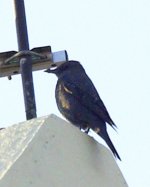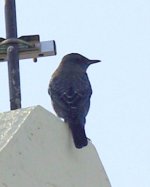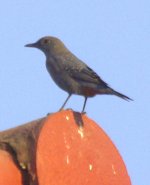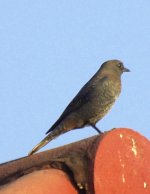I think Whistling Thrushes have yellow bills.
What's strange is that the first bird seems to be all blue-ish, and therefore I would assume pandoo, but the second bird has a red vent. Therefore the second one should logically be some kind of philippinensis (apparently a winter visitor), maybe a young male that hasn't got red on its chest yet. Or maybe it's some stage of a Chestnut-bellied Rock Thrush, which Robson says is resident?
But given how few birds in total we saw in Laos, it would be weird if two birds looking similar in the same place (and the only two birds seen in that place in four hours - our plane was delayed) turned out to be two species.
Total bird list for four days in Luang Prabang:
Tree Sparrow: a few, several times
Common Myna: one, once from a distance
Feral Pigeon: two, together on one occasion
Grey-backed Shrike: one, once
Sooty-headed Bulbul: two individuals in two places
Common Tailorbird: one, once
Dark-necked Tailorbird: one, once
Yellow-browed Warbler: two individuals in two places
Striated or Red-rumped swallow: one group noticed on one occasion
Fork-tailed Swift: one group noticed on one occasion
Some kind of wagtail: one bird seen from a great distance
Another air bird
And the two birds in the present thread
There were a couple of small birds that we didn't see clearly, which might have been different from these. But we went for a country walk and elephant ride, and the town is a small town with lots of green. It's on a join of the Mekong and a smaller river - we saw no birds at all on or near the river.
On the walk our guide said there are no animals left in the area as they've all been eaten, and I suspect that's what happened to most of the birds, too. In the market, they were selling roast bat.









